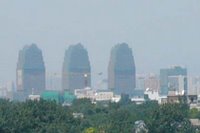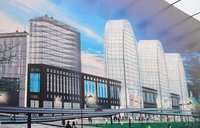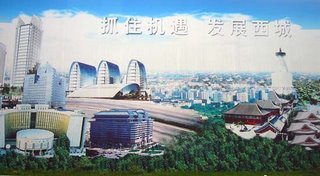


In 2008, Beijing is going to hold the Olympic Games, which the focus of the world is going to be on Beijing soon. Having the right of holding such international event, Beijing moves one more step forwards on its history of being international metropolitan. A slogan, “New Beijing. Great Olympics”, can be seen everywhere in the city from subway stations to shirts people wear. When the Olympic Games in 2008 are held in Beijing, the focus of the world is going to be on Beijing. The Chinese government wants to create one of the greatest Olympics. In order to achieve the goal, a new Beijing is needed to show the modernity of the country and its ability of an international city. Various constructions are added to Beijing to create the new Beijing.

As Oriental Plaza is at the east of Tiananmen, Occidental Plaza is under construction at the west of Beijing. Similarly to Oriental Plaza, Occidental Plaza has three buildings. However the buildings are much higher. The surface of both plazas is the same with crystal glasses but the new plaza is in a silvery transparent color making the buildings more lighted. The color of Occidental Plaza is parallel to the National Grand Theatre. Moreover, they share another similarity in their heights. They are much higher the buildings around them. Looking around the city from the Drum Tower, Occidental Plaza is the most distinguish high-rise at the west of Beijing.
Xi Cheng District which is west of Beijing inner city is at its full speed to development. Large advertisement boards including different modern and traditional structures can be found in different places at Xi Cheng District. Like the bill board shown above, is on the Chang’an Avenue in Xi Dan. It says “Grad the opportunity. Develop Xi Cheng District”. It is the age of development. Development is part of everyone’s mind. The preservation of the past culture is secondary compared to development. In the bill board, Occidental Plaza and Time Squares are placed almost in the middle of the board. The White Pavilion and siheyuans are put at the corner. This billboard’s center of focus is the westernized high-rises rather than the architectures from the past.
As the major cities in China become more prosperous, consumer culture becomes part of the mainstream culture. It will become more and more important as Olympics approach. Businessmen in Beijing will not waste this chance to make some money. Capitalism and materialism are the directions Beijing culture is going at. Most of the constructions sites are brand new apartments. The large amount of housing supplies means that there is a large amount of demands. A new consumer group merges as foreign companies coming in to Beijing paying them above average salaries. The middle class in Beijing starts to form and since they are more wealth and are brand-conscious, they are willing to spend more on goods or services. Consumer culture stimulates the economy and the economy stimulates the consumer culture.


Tiananmen Square is a phantasmagoric center throughout its existence. It has had a Hong Kong Clock before Hong Kong is handover to China to count down to the handover moment. Now at the east of the Square outside the National Museum of China, there is an Olympic clock counting down for Olympic Games in 2008. The clock looks into the future of Beijing bring the influence of Olympics to present. Moreover, the clock serves as an advertisement of the coming Olympics as well as an advertisement for Omega.
Looking at the clock, it is a combination of past and present and of Chinese and Western cultures. Chinese and English are the languages on the clock. "Beijing 2008" is in English and Arabic numerals. However, they are written in Chinese Calligraphy. The red and white symbol has two ways to interprete. It is a running person showing the athletic characteristics of the Olympics. It is also the Chinese character "Jing", which means the capital and represents Beijing. The Olympic Clock does not only link the present to the future, but also combines the different cultures together.



Holding a Great Olympics means tons preparations are needed. Constructions of different stadiums are the fundament. As the government value the event so importantly, designs of various stadiums have already confirmed. The location of the Olympic Park is also chosen. It is at the north of Beijing on the central axis. The Olympic Park extends the central axis outside of the inner city and adds to the overall development of the central axis. It reinforces the structural layout of historic Beijing and connects the past to the future. The style of the stadiums is similar to the National Grand Theatre with the color silver. Maybe the fresh feeling given by the color silver is a representation of future. Olympic Park is going to be one of the most important structures in Beijing. Its significance does not lie in its appearance but as a symbol of new Beijing.
Constructions of the various stadiums add to the overall style of Beijing's architectures. At the same time, the Olympic Games which is originally from Athens add new impact on the cultures of Beijing. An Olympic wave is coming to Beijing and transforms it into an Olympic City.
Silver is emerging to be the main colors of Beijing’s new constructions. Even though the architectural styles are still varied in many forms, there is possible to find a new harmony in color silver. Demolition and construction are going to slow down as Beijing transforms into an Olympic City. From then onward, a new Beijing with its own characteristics will be formed There will be a way to incorporate the heritages with the future making Beijing a living museum of history and time. For instance, the central axis shows Beijing’s past historical values, its communist characteristics and its future development. Similarly, new constructions in future are going to share the past, the present and the future. As a new Beijing emerges, the collective memory of the city is renewed. People in Beijing will have nostalgia of the past and expectation of the future at the same time. After the Olympics, Beijing will have some time to rest. Then the culture of Beijing will stabilize. It will not be a culture which includes everything it can get, but a culture that convert the new impact into its characteristics.

No comments:
Post a Comment